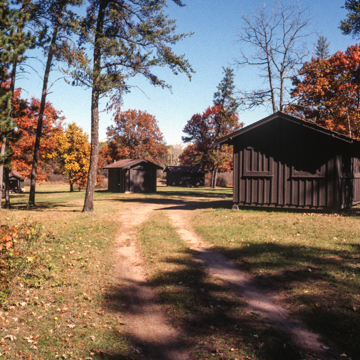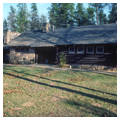You are here
St. Croix State Park
The St. Croix Recreational Demonstration Area was established during the New Deal as part of a federal program to demonstrate how submarginal lands could be retired from agricultural use and developed for recreational purposes. A Recreational Demonstration Area (RDA) was essentially a state park, but one built on an immense scale that could serve large numbers of the population. RDAs were built to provide outdoor experiences to underprivileged urban residents, specifically children.
The RDAs were considered one of the New Deal’s outstanding achievements in land use planning and recreation. Landscape architects of the National Park Service (NPS) applied newly developed principles of master planning to convert large tracts of land into recreational areas. With over 30,000 acres, St. Croix was one of the largest of the forty-six RDAs built throughout the United States. Landscape architects designed five primary areas for development at St. Croix, which were connected with over thirty miles of roads. Within this area are over 160 buildings and structures, designed by NPS architects and built by Civilian Conservation Corps and Works Progress Administration laborers.
The five developed areas at St. Croix include: the park headquarters, which contained the contact station, a large service yard, and a residential compound for staff; a public use area and campground, characteristic of what might be found at a typical state park; and three group camps named St. John’s Landing, Norway Point, and Head of the Rapids, respectively. Each of the developed areas is positioned on or near the St. Croix River, but all are located at least several miles apart, resulting in a decentralized design that takes full advantage of the site’s scenic and recreational opportunities and provides sufficient separation between the various use areas.
The buildings are representative of what would become known as the NPS Rustic style. The major structures were built using sandstone from nearby quarries or they feature a combination of log and stone construction, while secondary buildings were of rough board-and-batten siding. The park contains the most complete and extensive assemblage of finely crafted Rustic structures in the state park system.
Group camps were the hallmark of St. Croix and the entire RDA program. The NPS landscape architects aimed to eliminate the overcrowding and regimentation of existing group camp facilities by creating decentralized designs that emphasize individual needs and social relationships. Each group camp consisted of an administrative core, which included the camp office, infirmary, dining hall, staff quarters, and other service buildings, surrounded by a number of “units” or “cabin colonies” with cabins for campers and counselors, a lodge, and a wash house. Ideally, only four campers would share a cabin, and a cabin colony would accommodate no more than 24 campers; the entire group camp was designed for a maximum of 96 campers. St. John’s Landing and Norway Point were designed on these principles, while the Head of the Rapids is somewhat less decentralized in order to meet the needs of the disabled children for whom the camp was designed.
Work on the St. Croix RDA began in 1934 and was finished by 1942. During the Great Depression, social service agencies and youth organizations in urban areas, such as Minneapolis and St. Paul, recruited campers who would spend two weeks during the summer at the group camps of the St. Croix RDA. The property was owned and operated by the federal government in the early years but it had always been the intention to transfer ownership of the RDAs to their respective state governments. On May 14, 1943, the St. Croix RDA was transferred to the State of Minnesota and renamed St. Croix State Park.
References
Anderson, Rolf T., “St. Croix Recreational Demonstration Area,” Pine County, Minnesota. National Register of Historic Places Registration Form, 1995. National Park Service, U.S. Department of the Interior, Washington, D.C.
Anderson, Rolf T., Susan Begley, and Ethan Carr, “St. Croix Recreational Demonstration Area,” Pine County, Minnesota. National Register of Historic Places Registration Form, 1997. National Park Service, U.S. Department of Interior, Washington, D.C.
Writing Credits
If SAH Archipedia has been useful to you, please consider supporting it.
SAH Archipedia tells the story of the United States through its buildings, landscapes, and cities. This freely available resource empowers the public with authoritative knowledge that deepens their understanding and appreciation of the built environment. But the Society of Architectural Historians, which created SAH Archipedia with University of Virginia Press, needs your support to maintain the high-caliber research, writing, photography, cartography, editing, design, and programming that make SAH Archipedia a trusted online resource available to all who value the history of place, heritage tourism, and learning.












